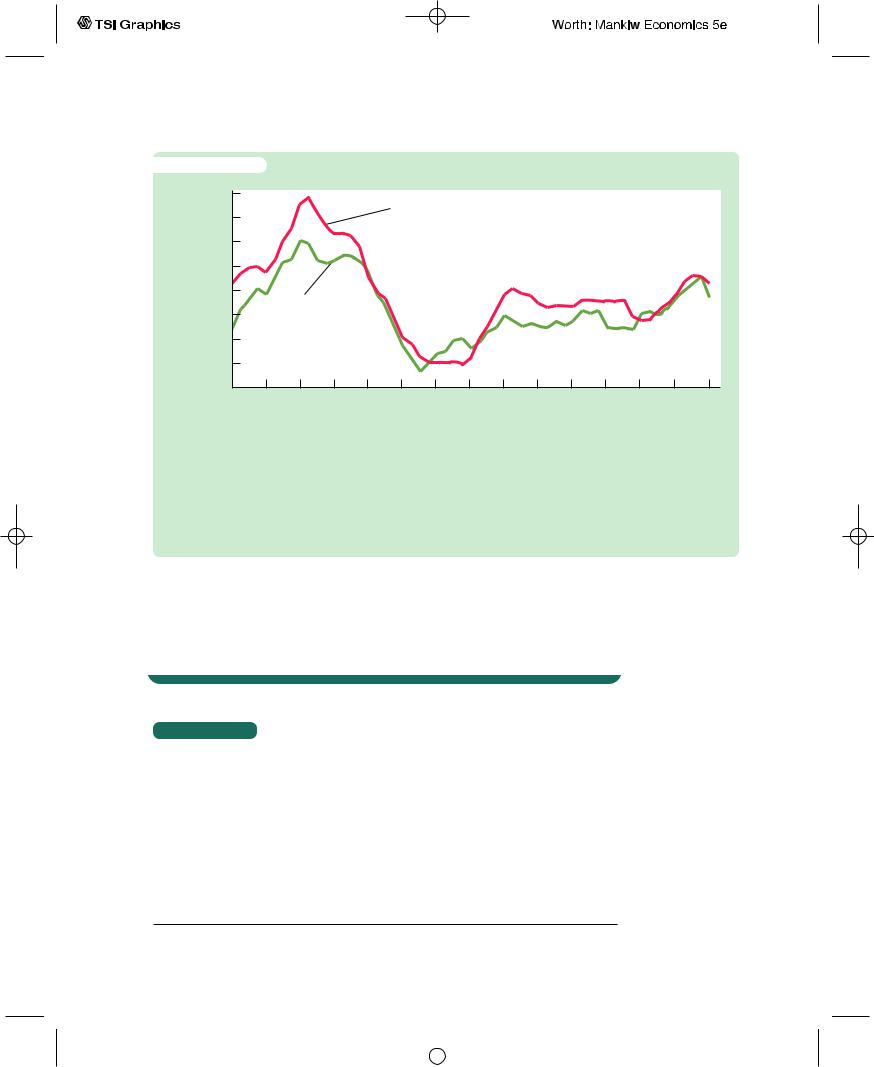
Mankiw Macroeconomics (5th ed)
.pdf
C H A P T E R 1 4 Stabilization Policy | 389
Reserve throughout the 1990s. His decisions about interest rates and the money supply kept the economy on track, avoiding both deep recession and runaway inflation.
14-2 Should Policy Be Conducted by Rule or by Discretion?
A second topic of debate among economists is whether economic policy should be conducted by rule or by discretion. Policy is conducted by rule if policymakers announce in advance how policy will respond to various situations and commit themselves to following through on this announcement. Policy is conducted by discretion if policymakers are free to size up events as they occur and choose whatever policy seems appropriate at the time.
The debate over rules versus discretion is distinct from the debate over passive versus active policy. Policy can be conducted by rule and yet be either passive or active. For example, a passive policy rule might specify steady growth in the money supply of 3 percent per year.An active policy rule might specify that
Money Growth = 3% + (Unemployment Rate − 6%).
Under this rule, the money supply grows at 3 percent if the unemployment rate is 6 percent, but for every percentage point by which the unemployment rate exceeds 6 percent, money growth increases by an extra percentage point.This rule tries to stabilize the economy by raising money growth when the economy is in a recession.
We begin this section by discussing why policy might be improved by a commitment to a policy rule.We then examine several possible policy rules.
Distrust of Policymakers and the Political Process
Some economists believe that economic policy is too important to be left to the discretion of policymakers. Although this view is more political than economic, evaluating it is central to how we judge the role of economic policy. If politicians are incompetent or opportunistic, then we may not want to give them the discretion to use the powerful tools of monetary and fiscal policy.
Incompetence in economic policy arises for several reasons. Some economists view the political process as erratic, perhaps because it reflects the shifting power of special interest groups. In addition, macroeconomics is complicated, and politicians often do not have sufficient knowledge of it to make informed judgments.This ignorance allows charlatans to propose incorrect but superficially appealing solutions to complex problems.The political process often cannot weed out the advice of charlatans from that of competent economists.
Opportunism in economic policy arises when the objectives of policymakers conflict with the well-being of the public. Some economists fear that politicians
User JOEWA:Job EFF01430:6264_ch14:Pg 389:27875#/eps at 100% *27875* |
Mon, Feb 18, 2002 1:03 AM |
|||
|
|
|
|
|
|
|
|
|
|

390 | P A R T V Macroeconomic Policy Debates
use macroeconomic policy to further their own electoral ends. If citizens vote on the basis of economic conditions prevailing at the time of the election, then politicians have an incentive to pursue policies that will make the economy look good during election years. A president might cause a recession soon after coming into office to lower inflation and then stimulate the economy as the next election approaches to lower unemployment; this would ensure that both inflation and unemployment are low on election day. Manipulation of the economy for electoral gain, called the political business cycle, has been the subject of extensive research by economists and political scientists.4
Distrust of the political process leads some economists to advocate placing economic policy outside the realm of politics. Some have proposed constitutional amendments, such as a balanced-budget amendment, that would tie the hands of legislators and insulate the economy from both incompetence and opportunism.
C A S E S T U D Y
The Economy Under Republican and Democratic Presidents
How does the political party in power affect the economy? Researchers working at the boundary between economics and political science have been studying this question. One intriguing finding is that the two political parties in the United States appear to conduct systematically different macroeconomic policies.
Table 14-2 presents the growth in real GDP in each of the four years of the presidential terms since 1948. Notice that growth is usually low, and often negative, in the second year of Republican administrations. Six of the eight years in which real GDP fell are second or third years of Republican administrations. By contrast, the economy is usually booming in the second and third years of Democratic administrations.
One interpretation of this finding is that the two parties have different preferences regarding inflation and unemployment.That is, rather than viewing politicians as opportunistic, perhaps we should view them as merely partisan. Republicans seem to dislike inflation more than Democrats do. Therefore, Republicans pursue contractionary policies soon after coming into office and are willing to endure a recession to reduce inflation. Democrats pursue more expansionary policies to reduce unemployment and are willing to endure the higher inflation that results. Examining growth in the money supply shows that monetary policy is, in fact, less inflationary during Republican administrations.Thus, it seems that the two political parties pursue dramatically different policies and that the political process is one source of economic fluctuations.
Even if we accept this interpretation of the evidence, it is not clear whether it argues for or against fixed policy rules. On the one hand, a policy rule would
4 William Nordhaus, “The Political Business Cycle,’’ Review of Economic Studies 42 (1975): 169–190; and Edward Tufte, Political Control of the Economy (Princeton, N. J.: Princeton University Press, 1978).
User JOEWA:Job EFF01430:6264_ch14:Pg 390:27876#/eps at 100% *27876* |
Mon, Feb 18, 2002 1:03 AM |
|||
|
|
|
|
|
|
|
|
|
|

C H A P T E R 1 4 Stabilization Policy | 391
t a b l e 1 4 - 2
Real GDP Growth During Republican and Democratic Administrations
|
|
|
|
YEAR OF TERM |
|
|
|
||||
|
|
|
|
|
|
|
|
|
|
|
|
President |
|
First |
Second |
Third |
Fourth |
||||||
|
|
|
|
|
|
|
|
|
|
|
|
Democratic Administrations |
|
|
|
|
|
|
|
|
|
|
|
Truman |
−0.6 |
8.9 |
7.6 |
|
3.7 |
|
|||||
Kennedy/Johnson |
2.3 |
6.0 |
4.3 |
|
5.8 |
|
|||||
Johnson |
6.4 |
6.6 |
2.5 |
|
4.8 |
|
|||||
Carter |
4.6 |
5.5 |
3.2 |
|
−0.2 |
||||||
Clinton I |
2.7 |
4.0 |
2.7 |
|
3.6 |
|
|||||
Clinton II |
|
4.4 |
|
4.4 |
4.2 |
|
5.0 |
|
|||
|
|
|
|
|
|
|
|
|
|
|
|
Average |
|
3.3 |
|
5.9 |
4.1 |
|
3.8 |
|
|||
Republican Administrations |
|
|
|
|
|
|
|
|
|
|
|
Eisenhower I |
4.6 |
|
−0.7 |
7.1 |
|
2.0 |
|
||||
Eisenhower II |
2.0 |
|
−1.0 |
7.2 |
|
2.5 |
|
||||
Nixon |
3.0 |
0.2 |
3.3 |
|
5.4 |
|
|||||
Nixon/Ford |
5.8 |
|
−0.6 |
|
−0.4 |
5.6 |
|
||||
Reagan I |
2.5 |
|
−2.0 |
4.3 |
|
7.3 |
|
||||
Reagan II |
3.8 |
3.4 |
3.4 |
|
4.2 |
|
|||||
Bush (elder) |
|
3.5 |
|
1.8 |
|
−0.5 |
3.0 |
|
|||
Average |
|
|
|
|
|
3.5 |
|
|
|
|
|
|
3.6 |
|
0.2 |
|
4.3 |
|
|||||
Source: Department of Commerce
insulate the economy from these political shocks. Under a fixed rule, the Fed would be unable to alter monetary policy in response to the changing political climate. The economy might be more stable, and long-run economic performance might be improved. On the other hand, a fixed policy rule would reduce the voice of the electorate in influencing macroeconomic policy.5
The Time Inconsistency of Discretionary Policy
If we assume that we can trust our policymakers, discretion at first glance appears superior to a fixed policy rule. Discretionary policy is, by its nature, flexible. As long as policymakers are intelligent and benevolent, there might appear to be little reason to deny them flexibility in responding to changing conditions.
Yet a case for rules over discretion arises from the problem of time inconsistency of policy. In some situations policymakers may want to announce in
5 Alberto Alesina,“Macroeconomics and Politics,’’ NBER Macroeconomics Annual 3 (1988): 13–52.
User JOEWA:Job EFF01430:6264_ch14:Pg 391:27877#/eps at 100% *27877* |
Mon, Feb 18, 2002 1:03 AM |
|||
|
|
|
|
|
|
|
|
|
|

392 | P A R T V Macroeconomic Policy Debates
advance the policy they will follow in order to influence the expectations of private decisionmakers. But later, after the private decisionmakers have acted on the basis of their expectations, these policymakers may be tempted to renege on their announcement. Understanding that policymakers may be inconsistent over time, private decisionmakers are led to distrust policy announcements. In this situation, to make their announcements credible, policymakers may want to make a commitment to a fixed policy rule.
Time inconsistency is illustrated most simply in a political rather than an economic example—specifically, public policy about negotiating with terrorists over the release of hostages.The announced policy of many nations is that they will not negotiate over hostages. Such an announcement is intended to deter terrorists: if there is nothing to be gained from kidnapping hostages, rational terrorists won’t kidnap any. In other words, the purpose of the announcement is to influence the expectations of terrorists and thereby their behavior.
But, in fact, unless the policymakers are credibly committed to the policy, the announcement has little effect.Terrorists know that once hostages are taken, policymakers face an overwhelming temptation to make some concession to obtain the hostages’ release.The only way to deter rational terrorists is to take away the discretion of policymakers and commit them to a rule of never negotiating. If policymakers were truly unable to make concessions, the incentive for terrorists to take hostages would be largely eliminated.
The same problem arises less dramatically in the conduct of monetary policy. Consider the dilemma of a Federal Reserve that cares about both inflation and unemployment. According to the Phillips curve, the tradeoff between inflation and unemployment depends on expected inflation.The Fed would prefer everyone to expect low inflation so that it will face a favorable tradeoff.To reduce expected inflation, the Fed might announce that low inflation is the paramount goal of monetary policy.
But an announcement of a policy of low inflation is by itself not credible. Once households and firms have formed their expectations of inflation and set wages and prices accordingly, the Fed has an incentive to renege on its announcement and implement expansionary monetary policy to reduce unemployment. People understand the Fed’s incentive to renege and therefore do not believe the announcement in the first place. Just as a president facing a hostage crisis is sorely tempted to negotiate their release, a Federal Reserve with discretion is sorely tempted to inflate in order to reduce unemployment. And just as terrorists discount announced policies of never negotiating, households and firms discount announced policies of low inflation.
The surprising outcome of this analysis is that policymakers can sometimes better achieve their goals by having their discretion taken away from them. In the case of rational terrorists, fewer hostages will be taken and killed if policymakers are committed to following the seemingly harsh rule of refusing to negotiate for hostages’ freedom. In the case of monetary policy, there will be lower inflation without higher unemployment if the Fed is committed to a policy of zero inflation. (This conclusion about monetary policy is modeled more explicitly in the appendix to this chapter.)
User JOEWA:Job EFF01430:6264_ch14:Pg 392:27878#/eps at 100% *27878* |
Mon, Feb 18, 2002 1:03 AM |
|||
|
|
|
|
|
|
|
|
|
|

C H A P T E R 1 4 Stabilization Policy | 393
The time inconsistency of policy arises in many other contexts. Here are some examples:
To encourage investment, the government announces that it will not tax income from capital. But after factories have been built, the government is tempted to renege on its promise to raise more tax revenue from them.
To encourage research, the government announces that it will give a temporary monopoly to companies that discover new drugs. But after a drug has been discovered, the government is tempted to revoke the patent or to regulate the price to make the drug more affordable.
To encourage good behavior, a parent announces that he or she will punish a child whenever the child breaks a rule. But after the child has misbehaved, the parent is tempted to forgive the transgression, because punishment is unpleasant for the parent as well as for the child.
To encourage you to work hard, your professor announces that this course will end with an exam. But after you have studied and learned all the material, the professor is tempted to cancel the exam so that he or she won’t have to grade it.
In each case, rational agents understand the incentive for the policymaker to renege, and this expectation affects their behavior. And in each case, the solution is to take away the policymaker’s discretion with a credible commitment to a fixed policy rule.
C A S E S T U D Y
Alexander Hamilton Versus Time Inconsistency
Time inconsistency has long been a problem associated with discretionary policy. In fact, it was one of the first problems that confronted Alexander Hamilton when President George Washington appointed him the first U.S. Secretary of the Treasury in 1789.
Hamilton faced the question of how to deal with the debts that the new nation had accumulated as it fought for its independence from Britain. When the revolutionary government incurred the debts, it promised to honor them when the war was over. But after the war, many Americans advocated defaulting on the debt because repaying the creditors would require taxation, which is always costly and unpopular.
Hamilton opposed the time-inconsistency policy of repudiating the debt. He knew that the nation would likely need to borrow again sometime in the future. In his First Report on the Public Credit, which he presented to Congress in 1790, he wrote
If the maintenance of public credit, then, be truly so important, the next inquiry which suggests itself is: By what means is it to be effected? The ready answer to which question is, by good faith; by a punctual performance of contracts. States,
User JOEWA:Job EFF01430:6264_ch14:Pg 393:27879#/eps at 100% *27879* |
Mon, Feb 18, 2002 1:03 AM |
|||
|
|
|
|
|
|
|
|
|
|

394 | P A R T V Macroeconomic Policy Debates
like individuals, who observe their engagements are respected and trusted, while the reverse is the fate of those who pursue an opposite conduct.
Thus, Hamilton proposed that the nation make a commitment to the policy rule of honoring its debts.
The policy rule that Hamilton originally proposed has continued for more than two centuries. Today, unlike in Hamilton’s time, when Congress debates spending priorities, no one seriously proposes defaulting on the public debt as a way to reduce taxes. In the case of public debt, everyone now agrees that the government should be committed to a fixed policy rule.
Rules for Monetary Policy
Even if we are convinced that policy rules are superior to discretion, the debate over macroeconomic policy is not over. If the Fed were to commit to a rule for monetary policy, what rule should it choose? Let’s discuss briefly three policy rules that various economists advocate.
Some economists, called monetarists, advocate that the Fed keep the money supply growing at a steady rate.The quotation at the beginning of this chapter from Milton Friedman—the most famous monetarist—exemplifies this view of monetary policy. Monetarists believe that fluctuations in the money supply are responsible for most large fluctuations in the economy.They argue that slow and steady growth in the money supply would yield stable output, employment, and prices.
Although a monetarist policy rule might have prevented many of the economic fluctuations we have experienced historically, most economists believe that it is not the best possible policy rule. Steady growth in the money supply stabilizes aggregate demand only if the velocity of money is stable. But sometimes the economy experiences shocks, such as shifts in money demand, that cause velocity to be unstable. Most economists believe that a policy rule needs to allow the money supply to adjust to various shocks to the economy.
A second policy rule that economists widely advocate is nominal GDP targeting. Under this rule, the Fed announces a planned path for nominal GDP. If nominal GDP rises above the target, the Fed reduces money growth to dampen aggregate demand. If it falls below the target, the Fed raises money growth to stimulate aggregate demand. Because a nominal GDP target allows monetary policy to adjust to changes in the velocity of money, most economists believe it would lead to greater stability in output and prices than a monetarist policy rule.
A third policy rule that is often advocated is inflation targeting. Under this rule, the Fed would announce a target for the inflation rate (usually a low one) and then adjust the money supply when the actual inflation deviates from the target. Like nominal GDP targeting, inflation targeting insulates the economy from changes in the velocity of money. In addition, an inflation target has the political advantage that it is easy to explain to the public.
Notice that all these rules are expressed in terms of some nominal variable— the money supply, nominal GDP, or the price level. One can also imagine policy rules expressed in terms of real variables. For example, the Fed might try to target the unemployment rate at 5 percent.The problem with such a rule is that no one
User JOEWA:Job EFF01430:6264_ch14:Pg 394:27880#/eps at 100% *27880* |
Mon, Feb 18, 2002 1:03 AM |
|||
|
|
|
|
|
|
|
|
|
|

C H A P T E R 1 4 Stabilization Policy | 395
knows exactly what the natural rate of unemployment is. If the Fed chose a target for the unemployment rate below the natural rate, the result would be accelerating inflation. Conversely, if the Fed chose a target for the unemployment rate above the natural rate, the result would be accelerating deflation. For this reason, economists rarely advocate rules for monetary policy expressed solely in terms of real variables, even though real variables such as unemployment and real GDP are the best measures of economic performance.
C A S E S T U D Y
Inflation Targeting: Rule or Constrained Discretion?
Since the late 1980s, many of the world’s central banks—including those of Australia, Canada, Finland, Israel, New Zealand, Spain, Sweden, and the United Kingdom—have adopted some form of an inflation target. Sometimes inflation targeting takes the form of a central bank announcing its policy intentions. Other times it takes the form of a national law that spells out the goals of monetary policy. For example, the Reserve Bank of New Zealand Act of 1989 told the central bank “to formulate and implement monetary policy directed to the economic objective of achieving and maintaining stability in the general level of prices.”The act conspicuously omitted any mention of any other competing objective, such as stability in output, employment, interest rates, or exchange rates. Although the U.S. Federal Reserve has not adopted inflation targeting, some members of Congress have proposed bills that would require the Fed to do so.
Should we interpret inflation targeting as a type of precommitment to a policy rule? Not completely. In all the countries that have adopted inflation targeting, central banks are left with a fair amount of discretion. Inflation targets are usually set as a range—an inflation rate of 1 to 3 percent, for instance—rather than a particular number.Thus, the central bank can choose where in the range it wants to be. In addition, the central banks are sometimes allowed to adjust their targets for inflation, at least temporarily, if some exogenous event (such as an easily identified supply shock) pushes inflation outside of the range that was previously announced.
In light of this flexibility, what is the purpose of inflation targeting? Although inflation targeting does leave the central bank with some discretion, the policy does constrain how this discretion is used.When a central bank is told to “do the right thing,” it is hard to hold the central bank accountable, because people can argue forever about what the right thing is in any specific circumstance. By contrast, when a central bank has announced an inflation target, the public can more easily judge whether the central bank is meeting that target.Thus, although inflation targeting does not tie the hands of the central bank, it does increase the transparency of monetary policy and, by doing so, makes central bankers more accountable for their actions.6
6 See Ben S. Bernanke and Frederic S. Mishkin,“Inflation Targeting:A New Framework for Monetary Policy?” Journal of Economic Perspectives 11 (Spring 1997): 97–116.
User JOEWA:Job EFF01430:6264_ch14:Pg 395:27881#/eps at 100% *27881* |
Mon, Feb 18, 2002 1:03 AM |
|||
|
|
|
|
|
|
|
|
|
|

396 | P A R T V Macroeconomic Policy Debates
C A S E S T U D Y
John Taylor’s (and Alan Greenspan’s?) Rule for Monetary Policy
If you wanted to set interest rates to achieve stable prices while avoiding large fluctuations in output and employment, how would you do it? This is exactly the question that Alan Greenspan and the other governors of the Federal Reserve must ask themselves every day. The short-term policy instrument that the Fed now sets is the federal funds rate—the short-term interest rate at which banks make loans to one another. Whenever the Federal Open Market Committee meets, it chooses a target for the federal funds rate. The Fed’s bond traders are then told to conduct open-market operations in order to hit the desired target.
The hard part of the Fed’s job is choosing the target for the federal funds rate. Two guidelines are clear. First, when inflation heats up, the federal funds rate should rise. An increase in the interest rate will mean a smaller money supply and, eventually, lower investment, lower output, higher unemployment, and reduced inflation. Second, when real economic activity slows—as reflected in real GDP or unemployment—the federal funds rate should fall.A decrease in the interest rate will mean a larger money supply and, eventually, higher investment, higher output, and lower unemployment.
The Fed needs to go beyond these general guidelines, however, and decide how much to respond to changes in inflation and real economic activity.To help it make this decision, economist John Taylor has proposed a simple rule for the federal funds rate:
Nominal Federal Funds Rate = Inflation + 2.0
+ 0.5 (Inflation − 2.0) − 0.5 (GDP Gap).
The GDP gap is the percentage shortfall of real GDP from an estimate of its natural rate.
Taylor’s rule has the real federal funds rate—the nominal rate minus infla- tion—responding to inflation and the GDP gap. According to this rule, the real federal funds rate equals 2 percent when inflation is 2 percent and GDP is at its natural rate. For each percentage point by which inflation rises above 2 percent, the real federal funds rate rises by 0.5 percent. For each percentage point by which real GDP falls below its natural rate, the real federal funds rate falls by 0.5 percent. If GDP rises above its natural rate, so that the GDP gap is negative, the real federal funds rate rises accordingly.
One way to view the Taylor rule is as a complement to (rather than a substitute for) inflation targeting.As the previous case study discussed, inflation targeting offers a plan for the central bank in the medium run, but it does not constrain its month-to-month policy decisions. The Taylor rule may be a good short-run operating procedure for hitting a medium-run inflation target. According to the Taylor rule, monetary policy responds directly to inflation—as any inflation-targeting central bank must. But it also responds to the output gap, which can be viewed as a measure of inflationary pressures.
Taylor’s rule for monetary policy is not only simple and reasonable, but it also resembles actual Fed behavior in recent years. Figure 14-2 shows the actual fed-
User JOEWA:Job EFF01430:6264_ch14:Pg 396:27882#/eps at 100% *27882* |
Mon, Feb 18, 2002 1:03 AM |
|||
|
|
|
|
|
|
|
|
|
|

|
|
|
|
|
|
|
|
|
C H A P T E R 1 4 |
Stabilization Policy | 397 |
|||||
f i g u r e |
1 4 - 2 |
|
|
|
|
|
|
|
|
|
|
|
|
|
|
Percent |
10 |
|
|
|
|
Actual |
|
|
|
|
|
|
|
|
|
|
9 |
|
|
|
|
|
|
|
|
|
|
|
|
|
|
|
|
|
|
|
|
|
|
|
|
|
|
|
|
|
|
|
8 |
|
|
|
|
|
|
|
|
|
|
|
|
|
|
|
7 |
|
|
|
|
|
|
|
|
|
|
|
|
|
|
|
6 |
|
Taylor’s rule |
|
|
|
|
|
|
|
|
|
|
|
|
|
|
|
|
|
|
|
|
|
|
|
|
|
|
||
|
5 |
|
|
|
|
|
|
|
|
|
|
|
|
|
|
|
4 |
|
|
|
|
|
|
|
|
|
|
|
|
|
|
|
3 |
|
|
|
|
|
|
|
|
|
|
|
|
|
|
|
2 |
1988 |
1989 |
1990 |
1991 |
1992 |
1993 |
1994 |
1995 |
1996 |
1997 |
1998 |
1999 |
2000 |
2001 |
|
1987 |
||||||||||||||
|
|
|
|
|
|
|
|
|
|
|
|
|
|
|
Year |
The Federal Funds Rate: Actual and Suggested This figure shows the federal funds rate—the short-term interest rate at which banks make loans to each other. It also shows the federal funds rate suggested by John Taylor’s monetary rule. Notice that the two series move closely together.
Source: Federal Reserve Board, U.S. Department of Commerce, and author’s calculations. To implement the Taylor rule, the inflation rate is measured as the percentage change in the GDP deflator over the previous four quarters, and the GDP gap is measured as twice the deviation of the unemployment rate from 6 percent.
eral funds rate and the target rate as determined by Taylor’s proposed rule. Notice how closely together the two series move. John Taylor’s monetary rule may be more than an academic suggestion. It may be the rule that Alan Greenspan and his colleagues subconsciously follow.7
C A S E S T U D Y
Central-Bank Independence
Suppose you were put in charge of writing the constitution and laws for a country. Would you give the president of the country authority over the policies of the central bank? Or would you allow the central bank to make decisions free from such political influence? In other words, assuming that monetary policy is made by discretion rather than by rule, who should exercise that discretion?
Countries vary greatly in how they choose to answer this question. In some countries, the central bank is a branch of the government; in others, the central
7 John B. Taylor, “The Inflation/Output Variability Tradeoff Revisited,” in Goals, Guidelines, and Constraints Facing Monetary Policymakers (Federal Reserve Bank of Boston, 1994).
User JOEWA:Job EFF01430:6264_ch14:Pg 397:27883#/eps at 100% *27883* |
Mon, Feb 18, 2002 1:03 AM |
|||
|
|
|
|
|
|
|
|
|
|

398 | P A R T V Macroeconomic Policy Debates
bank is largely independent. In the United States, Fed governors are appointed by the president for 14-year terms, and they cannot be recalled if the president is unhappy with their decisions.This institutional structure gives the Fed a degree of independence similar to that of the Supreme Court.
Many researchers have investigated the effects of constitutional design on monetary policy.They have examined the laws of different countries to construct an index of central-bank independence.This index is based on various characteristics, such as the length of bankers’ terms, the role of government officials on the bank board, and the frequency of contact between the government and the central bank. The researchers then examined the correlation between central-bank independence and macroeconomic performance.
The results of these studies are striking: more independent central banks are strongly associated with lower and more stable inflation. Figure 14-3 shows a scatterplot of central-bank independence and average inflation for the period 1955 to 1988. Countries that had an independent central bank, such as Germany, Switzerland, and the United States, tended to have low average inflation. Countries that had central banks with less independence, such as New Zealand and Spain, tended to have higher average inflation.
Researchers have also found there is no relationship between central-bank independence and real economic activity. In particular, central-bank independence is not correlated with average unemployment, the volatility of unem-
f i g u r e |
1 4 - 3 |
|
|
|
|
|
|
|
|
|
|
|
|
|
|
|
|
|
|
|
||
Average |
9 |
|
|
|
|
|
|
|
|
|
|
|
|
|
|
|
|
|
|
|
|
|
|
|
|
|
|
|
|
|
|
|
|
|
|
|
|
|
|
|
|
|
|
||
|
|
|
|
|
|
|
|
|
|
|
|
|
|
|
|
|
|
|
|
|
||
inflation |
|
|
|
|
|
|
|
Spain |
|
|
|
|
|
|
|
|
|
|
|
|||
|
8 |
|
|
|
|
|
|
|
|
|
|
|
|
|
|
|
|
|
||||
|
|
|
|
New Zealand |
|
|
|
|
|
|
|
|
|
|
|
|||||||
|
|
|
|
|
|
|
|
|
|
|
|
|
|
|
||||||||
|
|
|
|
|
|
|
|
|
|
|
|
|
|
|
|
|||||||
|
|
|
|
|
|
|
|
|
|
|
|
|
|
|
|
|||||||
|
7 |
|
|
|
|
|
|
|
|
Italy |
United Kingdom |
|
|
|
|
|
|
|
|
|
||
|
|
|
|
|
|
|
|
|
|
|
|
|
|
|
|
|
|
|||||
|
|
|
|
|
|
|
|
|
|
|
|
|
|
|
|
|
|
|||||
|
|
|
|
|
|
|
|
|
|
|
|
|
|
|
|
|
|
|
|
|||
|
|
|
|
|
|
|
|
Australia |
|
|
Denmark |
|
|
|
|
|
|
|
|
|
||
|
6 |
|
|
|
|
|
|
|
France/Norway/Sweden |
|
|
|
|
|
|
|
||||||
|
|
|
|
|
|
|
|
|
|
|
|
|
|
|
|
|
|
|||||
|
|
|
|
|
|
|
|
|
|
|
|
|
|
|
|
|
|
|||||
|
5 |
|
|
|
|
|
|
|
|
|
|
|
Japan |
|
|
|
|
|
|
|
|
|
|
|
|
|
|
|
|
|
|
|
|
|
|
|
|
|
|
|
|
|
|
||
|
|
|
|
|
|
|
|
|
|
|
|
|
Canada |
|
|
|
|
|
|
|
|
|
|
|
|
|
|
|
|
|
|
|
|
|
|
|
|
|
|
|
|
|
|
|
|
|
4 |
|
|
|
|
|
|
Belgium |
|
|
Netherlands |
|
|
|
United States |
|||||||
|
|
|
|
|
|
|
|
|
|
|
|
|
|
|
|
|
|
|
|
Switzerland |
||
|
3 |
|
|
|
|
|
|
|
|
|
|
|
|
|
|
|
|
|
|
|
||
|
|
|
|
|
|
|
|
|
|
|
|
|
|
|
|
|
|
|
|
|||
|
|
|
|
|
|
|
|
|
|
|
|
|
|
|
|
|
|
|
|
Germany |
||
|
|
|
|
|
|
|
|
|
|
|
|
|
|
|
|
|
|
|
|
|||
|
2 |
|
|
|
|
|
|
|
|
|
|
|
|
|
|
|
|
|
|
|
|
|
|
|
|
|
|
|
|
|
|
|
|
|
|
|
|
|
|
|
|
|
|
|
|
|
|
|
1 |
1.5 |
2 |
2.5 |
3 |
3.5 |
4 |
4.5 |
||||||||||||
|
0.5 |
|
||||||||||||||||||||
Index of central-bank independence
Inflation and Central-Bank Independence This scatterplot presents the international experience with central-bank independence. The evidence shows that moreindependent central banks tend to produce lower rates of inflation.
Source: Figure 1a, page 155, of Alberto Alesina and Lawrence H. Summers, “Central Bank
Independence and Macroeconomic Performance: Some Comparative Evidence,” Journal of Money,
Credit, and Banking 25 (May 1993): 151–162. Average inflation is for the period 1955–1988.
User JOEWA:Job EFF01430:6264_ch14:Pg 398:27884#/eps at 100% *27884* |
Mon, Feb 18, 2002 1:03 AM |
|||
|
|
|
|
|
|
|
|
|
|
